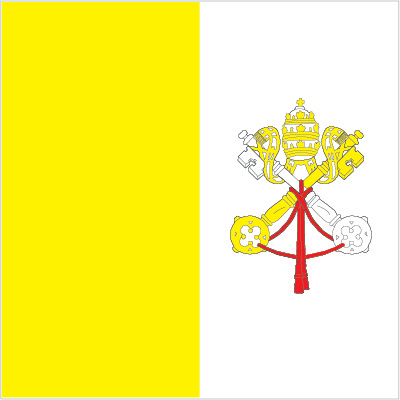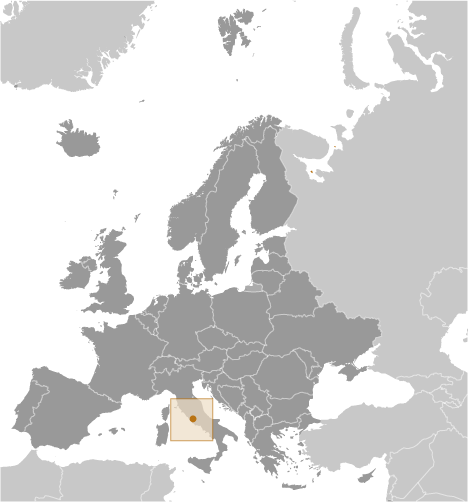conventional long form: The Holy See (Vatican City State)
conventional short form: Holy See (Vatican City)
local long form: La Santa Sede (Stato della Citta del Vaticano)
local short form: Santa Sede (Citta del Vaticano)
etymology: "holy" comes from the Greek word "hera" meaning "sacred"; "see" comes from the Latin word "sedes" meaning "seat," and refers to the episcopal chair; the term "Vatican" derives from the hill Mons Vaticanus on which the Vatican is located and which comes from the Latin "vaticinari" (to prophecy), referring to the fortune tellers and soothsayers who frequented the area in Roman times
ecclesiastical elective monarchy; self described as an "absolute monarchy"
name: Vatican City
geographic coordinates: 41 54 N, 12 27 E
time difference: UTC+1 (6 hours ahead of Washington, DC, during Standard Time)
daylight saving time: +1hr, begins last Sunday in March; ends last Sunday in October
none
11 February 1929; note - the three treaties signed with Italy on 11 February 1929 acknowledged, among other things, the full sovereignty of the Holy See and established its territorial extent; however, the origin of the Papal States, which over centuries varied considerably in extent, may be traced back to 754
Election Day of Pope FRANCIS, 13 March (2013)
previous 1929, 1963; latest adopted 26 November 2000, effective 22 February 2001 (Fundamental Law of Vatican City State); note - in October 2013, Pope Francis instituted a 9-member Council of Cardinal Advisors to reform the administrative apparatus of the Holy See (Roman Curia) to include writing a new constitution (2016)
religious legal system based on canon (religious) law
has not submitted an ICJ jurisdiction declaration; non-party state to the ICCt
citizenship by birth: no
citizenship by descent: no
dual citizenship recognized: no
residency requirement for naturalization: not applicable
note: in the Holy See, citizenship is acquired by law, ex iure, or by adminstrative decision; in the first instance citizenship is a function of holding office within the Holy See as in the case of cardinals resident in Vatican City or diplomats of the Holy See; in the second instance, citizenship may be requested in a limited set of circumstances for those who reside within Vatican City under papal authorization, as a function of their office or service, or as the spouses and children of current citizens; citizenship is lost once an individual no longer permanently resides in Vatican City, normally reverting to the citizenship previously held
election of the pope is limited to cardinals less than 80 years old
chief of state: Pope FRANCIS (since 13 March 2013)
head of government: Secretary of State Cardinal Pietro PAROLIN (since 15 October 2013)
cabinet: Pontifical Commission for the State of Vatican City appointed by the pope
elections/appointments: pope elected by the College of Cardinals, usually for life or until voluntary resignation; election last held on 13 March 2013 (next to be held after the death or resignation of the current pope); Secretary of State appointed by the pope
election results: Jorge Mario BERGOGLIO, former Archbishop of Buenos Aires, elected Pope FRANCIS
description: unicameral Pontifical Commission for Vatican City State or Pontificia Commissione per lo Stato della Citta del Vaticano (7 seats; members appointed by the pope to serve 5-year terms)
highest court(s): Supreme Court or Supreme Tribunal of the Apostolic Signatura (consists of the cardinal prefect, who serves as ex-officio president of the court, and 2 other cardinals of the Prefect Signatura); note - judicial duties were established by the Motu Proprio, papal directive, of Pope PIUS XII on 1 May 1946; most Vatican City criminal matters are handled by the Republic of Italy courts
judge selection and term of office: cardinal prefect appointed by the pope; the other 2 cardinals of the court appointed by the cardinal prefect on a yearly basis
subordinate courts: Appellate Court of Vatican City; Tribunal of Vatican City
none
none (exclusive of influence exercised by church officers)
CE (observer), IAEA, Interpol, IOM, ITSO, ITU, ITUC (NGOs), OAS (observer), OPCW, OSCE, Schengen Convention (de facto member), SICA (observer), UN (observer), UNCTAD, UNHCR, Union Latina (observer), UNWTO (observer), UPU, WIPO, WTO (observer)
chief of mission: Apostolic Nuncio Archbishop Christophe PIERRE (since 27 June 2016)
chancery: 3339 Massachusetts Avenue NW, Washington, DC 20008
telephone: [1] (202) 333-7121
FAX: [1] (202) 337-4036
chief of mission: Ambassador Kenneth Francis HACKETT (since 21 October 2013)
embassy: American Embassy to the Holy See, Via Sallustiana, 49, 00187 Rome, Italy
mailing address: Unit 5660, Box 66, DPO AE 09624-0066
telephone: [39] (06) 4674-3428
FAX: [39] (06) 575-8346
two vertical bands of yellow (hoist side) and white with the arms of the Holy See, consisting of the crossed keys of Saint Peter surmounted by the three-tiered papal tiara, centered in the white band; the yellow color represents the pope's spiritual power, the white his worldly power
crossed keys beneath a papal tiara; national colors: yellow, white
name: "Inno e Marcia Pontificale" (Hymn and Pontifical March); often called The Pontifical Hymn
lyrics/music: Raffaello LAVAGNA/Charles-Francois GOUNOD
note: adopted 1950
The Holy See is supported financially by a variety of sources, including investments, real estate income, and donations from Catholic individuals, dioceses, and institutions; these help fund the Roman Curia (Vatican bureaucracy), diplomatic missions, and media outlets. Moreover, an annual collection taken up in dioceses and from direct donations go to a non-budgetary fund, known as Peter's Pence, which is used directly by the pope for charity, disaster relief, and aid to churches in developing nations. Donations increased between 2010 and 2011.
The separate Vatican City State budget includes the Vatican museums and post office and is supported financially by the sale of stamps, coins, medals, and tourist mementos; by fees for admission to museums; and by publication sales. Its revenues increased between 2010 and 2011 because of expanded opening hours and a growing number of visitors. However, the Holy See has not escaped the financial difficulties engulfing other European countries; in 2012, it started a spending review to determine where to cut costs to reverse its 2011 budget deficit of $20 million. The Holy See generated a modest surplus in 2012 before recording a $32 million deficit in 2013, driven primarily by the decreasing value of gold. Most public expenditures go to wages and other personnel costs; the incomes and living standards of lay workers are comparable to those of counterparts who work in the city of Rome. In February 2014, Pope FRANCIS created the Secretariat of the Economy to oversee financial and administrative operations of the Holy See, part of a broader campaign to reform the Holy See’s finances.
$NA
printing; production of coins, medals, postage stamps; mosaics, staff uniforms; worldwide banking and financial activities
2,885 (December 2011)
country comparison to the world: 225
note: essentially services with a small amount of industry; nearly all dignitaries, priests, nuns, guards, and the approximately 3,000 lay workers live outside the Vatican
NA%
revenues: $308 million
expenditures: $326.4 million (2011)
NA%
NA%
calendar year
euros (EUR) per US dollar -
0.885 (2015 est.)
0.7525 (2014 est.)
0.7634 (2013 est.)
0.78 (2012 est.)
0.7185 (2011 est.)
























